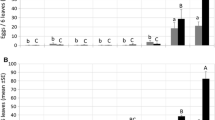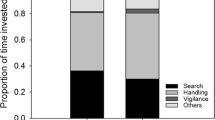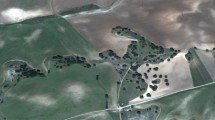Abstract
Although food-hoarding animals benefit plant seeds by generating predation pressure on granivorous insects, we lack experimental evidence of whether the tripartite interactions maintain a mutualistic relationship between the third trophic level and primary producers. Relying on the behavior of shelling, Siberian chipmunks (Tamias sibiricus) selectively consumed weevil larvae infested in acorns of Mongolian oak (Quercus mongolica) but chose the non-infested acorns to scatter-hoard. Shelling not only reduced volatile emission from acorns but also decreased cache loss to pilferers, weevil larvae and fungi, allowing T. sibiricus to gain more rewards from their caches. Moreover, shelling by T. sibiricus enhanced acorn germination and seedling establishment of Q. mongolica, possibly due to the diminishment of the negative effects of weevil infestation on acorn viability. Here, we show that both food-hoarding animal T. sibiricus and oak Q. mongolica can be conditionally benefited from selective predation on weevil larvae inside acorns. Our results highlight the need to integrate the mutualisms between the third and first trophic level into the tripartite interaction model. We suggest that more efforts should be made in the tripartite interactions of food-hoarding animals, seeds and granivorous insects.




Similar content being viewed by others
References
Akimoto T, Cho S, Yoshida H, Furuta H, Esashi Y (2004) Involvement of acetaldehyde in seed deterioration of some recalcitrant woody species through the acceleration of aerobic respiration. Plant Cell Physiol 45:201–210
Bartlow AW, Agosta SJ, Curtis R, Yi X, Steele MA (2018) Acorn size and tolerance to seed predators: the multiple roles of acorns as food for seed predators, fruit for dispersal and fuel for growth. Integr Zool 13:248–263
Bell DM, Clark JS (2016) Seed predation and climate impacts on reproductive variation in temperate forests of the southeastern USA. Oecologia 180:1223–1234
Bogdziewicz M, Espelta JM, Muñoz A, Aparicio JM, Bonal R (2018) Effectiveness of predator satiation in masting oaks is negatively affected by conspecific density. Oecologia 186:1–11
Bonal R, Muñoz A (2007) Multi-trophic effects of ungulate intraguild predation on acorn weevils. Oecologia 152:533–540
Bonal R, Muñoz A (2008) Negative consequences of premature seed abscission on insect performance: acorn growth suppression constraints Curculio elephas larval size. Ecol Entomol 33:31–36
Bonal R, Muñoz A (2009) Seed weevils living on the edge: pressures and conflicts over body size in the endoparasitic Curculio larvae. Ecol Entomol 34:304–309
Bonal R, Muñoz A, Díaz M (2007) Satiation of predispersal both plant and seed levels. Evol Ecol 21:367–380
Bossema I (1979) Jays and oaks: an eco-ethological study of a symbiosis. Behaviour 70:1–117
Cao L, Guo C, Chen J (2016) Fluctuation in seed abundance has contrasting effects on the fate of seeds from two rapidly geminating tree species in an Asian tropical forest. Integr Zool 12:2–11
Carlson JE, Holsinger KE (2010) Natural selection on inflorescence color polymorphisms in wild protea populations: the role of pollinators, seed predators, and intertrait correlations. Am J Bot 97:934–944
Chen Q, Tomlinson KW, Lin C, Wang B (2017) Effects of fragmentation on the seed predation and dispersal by rodents differ among species with different seed size. Integr Zool 12:468–476
Colville L, Bradley EL, Lloyd AS, Pritchard HW, Castle L, Kranner I (2012) Volatile fingerprints of seeds of four species indicate the involvement of alcoholic fermentation, lipid peroxidation, and Maillard reactions in seed deterioration during ageing and desiccation stress. J Exp Bot 63:6519–6530
Development Core Team R (2014) R: a language and environment for statistical computing, version 3.4.1. R Foundation for Statistical Computing, Vienna
Dixon MD, Johnson WC, Adkisson CS (1997) Effects of weevil larvae on acorn use by blue jays. Oecologia 111:201–208
Espelta JM, Cortés P, Molowny-Horas R, Retana J (2009) Acorn crop size and pre-dispersal predation determine inter-specific differences in the recruitment of co-occurring oaks. Oecologia 161:559–568
Estes JA, Terborgh J, Brashares JS, Power ME, Berger J, Bond WJ et al (2011) Trophic downgrading of planet earth. Science 333:301–306
Grinath JB, Inouye BD, Underwood N (2015) Bears benefit plants via a cascade with both antagonistic and mutualistic interactions. Ecol Lett 18:164–173
Gu H, Zhao Q, Zhang Z (2017) Does scatter-hoarding of seeds benefit cache owners or pilferers? Integr Zool 12:477–488
Guo CR, Lu JQ, Yang DZ, Zhao LP (2009) Impacts of burial and insect infection on germination and seedling growth of acorns of Quercus variabilis. For Ecol Manag 258:1497–1502
Hadj-Chikh LZ, Steele MA, Smallwood PD (1996) Caching decisions by grey squirrels: a test of the handling time and perishability hypotheses. Anim Behav 52:941–948
Herrera J (1995) Acorn predation and seedling production in a low-density population of cork oak (Quercus suber L.). For Ecol Manag 76:197–201
Higaki M (2016) Prolonged diapause and seed predation by the acorn weevil, Curculio robustus, in relation to masting of the deciduous oak Quercus acutissima. Entomol Exp Appl 159:338–346
Hollander JL, Longland WS (2012) Olfactory detection of caches containing wildland versus cultivated seeds by granivorous rodents. West N Am Nat 72:339–347
Hou X, Yi X, Yang Y, Liu W (2010) Acorn germination and seedling survival of Q. variabilis: effects of cotyledon excision. Ann For Sci 67:711
Hubbard JA, McPherson GR (1997) Acorn selection by Mexican jays: a test of a tri-trophic symbiotic relationship hypothesis. Oecologia 110:143–146
Jenkins JR, Devenport LD (2014) Seed preparation diminishes cache loss in least chipmunks. J Mammal 95:276–283
Johnson WC, Thomas L, Adkisson CS (1993) Dietary circumvention of acorn tannins by blue jays: implications for oak demography. Oecologia 94:159–164
Li Y, Zhang D, Zhang H, Wang Z, Yi X (2018) Scatter-hoarding animal places more memory on caches with weak odor. Behav Ecol Sociobiol 72:53
Liu Y, Liu G, Li Q, Liu Y, Hou L, Li G (2012) Influence of pericarp, cotyledon and inhibitory substances on sharp tooth oak (Quercus aliena var. acuteserrata) germination. PLoS One 7:e47682
Lombardo JA, McCarthy BC (2008) Forest management and Curculionid weevil diversity in mixed oak forest in southeastern Ohio. Nat Areas J 28:363–369
Lombardo JA, McCarthy BC (2009) Seed germination and seedling vigor of weevil-damaged acorns of red oak. Can J For Res 39:1600–1605
Madeira J, Fernandes GW, González-Rodríguez A, Cuevas-Reyes P (2013) Tri-trophic interactions among congeneric sympatric host plants of Chamaecrista, seed predators and parasitoids. Arthropod Plant Interact 7:403–413
Nakamura M, Hirata R, Oishi K, Arakaki T, Takamatsu N, Hata K, Sone K (2013) Determinant factors in the seedling establishment of Pasania edulis (Makino) Makino. Ecol Res 28:811–820
Neuschulz EL, Mueller T, Bollmann K, Gugerli F, Böhninggaese K (2014) Seed perishability determines the caching behaviour of a food-hoarding bird. J Anim Ecol 84:71–78
Paulsen TR, Colville L, Kranner I, Daws MI, Högstedt G, Vandvik V, Thompson K (2013) Physical dormancy in seeds: a game of hide and seek? New Phytol 198:496–503
Paulsen TR, Högstedt G, Thompson K, Vandvik V, Eliassen S, Leishman M (2014) Conditions favouring hard seededness as a dispersal and predator escape strategy. J Ecol 102:1475–1484
Pélisson PF, Bel-Venner MC, Rey B, Burgevin L, Martineau F, Fourel F, Lecuyer C, Menu F, Venner S (2012) Contrasted breeding strategies in four sympatric sibling insect species: when a proovigenic and capital breeder copes with a stochastic environment. Funct Ecol 26:198–206
Perea R, López D, Miguel AS, Gil L (2012a) Incorporating insect infestation into rodent seed dispersal: better if the larva is still inside. Oecologia 170:723–733
Perea R, Miguel AS, Martínez-Jauregui M, Valbuena-Carabaña M, Gil L (2012b) Effects of seed quality and seed location on the removal of acorns and beechnuts. Eur J For Res 131:623–631
Semel B, Andersen DC (1988) Vulnerability of acorn weevils (Coleoptera: Curculionidae) and attractiveness of weevils and infested Quercus alba acorns to Peromyscus leucopus and Blarina brevicauda. Am Midl Nat 119:385–393
Sone K, Oishi K, Shibato T, Hata K (2016) Effects of acorn attack by Curculio weevils on the germination and early growth of Pasania edulis, (Makino) seedlings. J For Res 21:1–8
Steele MA, HadjChikh LZ, Hazeltine J (1996) Caching and feeding decisions by Sciurus carolinensis: responses to weevil-infested acorns. J Mammal 77:305–314
Terborgh J, Estes JA (2010) Trophic cascades: predators, prey and the changing dynamics of nature. Island Press, Washington DC
Udaka H, Sinclair BJ (2014) The overwintering biology of the acorn weevil, Curculio glandium in southwestern Ontario. J Therm Biol 44:103–109
Vander Wall SB, Briggs JS, Jenkins SH, Kuhn KM, Thayer TC, Beck MJ (2006) Do food-hoarding animals have a cache recovery advantage? Determining recovery of stored food. Anim Behav 72:189–197
Venner S, Pelisson PF, Bel-Venner MC, Debias F, Rajon E, Menu F (2011) Coexistence of insect species competing for a pulsed resource: toward a unified theory of biodiversity in fluctuating environments. PLoS One 6:e18039
Visser MD, Muller-Lau HC, Joseph WS, Gemma R, Jansen PA (2011) Tri-trophic interactions affect density dependence of seed fate in a tropical forest palm. Ecol Lett 14:1093–1100
Wang X, Xiao Z, Zhang Z, Pan H (2008) Insect seed predation and its relationships with seed crop and seed size of Quercus mongolica. Acta Entomol Sin 51:161–165
Weckerly FW, Nicholson KE, Semlitch RD (1989) Experimental test of discrimination by squirrels for insect-infested and non-infested acorns. Am Midl Nat 122:412–415
Wootton JT (1994) The nature and consequences of indirect effects in ecological communities. Ann Rev Ecol Syst 25:443–466
Wróbel A, Zwolak R (2017) Deciphering the effects of disperser assemblages and seed mass on patterns of seed dispersal in a rodent community. Integr Zool 12:579–585
Xiao Z, Wang Y, Zhang Z (2003) Rodent’s ability to discriminate weevil-infested nuts by rodents: potential effects on regeneration of nut-bearing plants. Acta Theriol Sin 23:312–320
Xiao Z, Mi X, Holyoak M, Xie W, Cao K, Yang X, Huang X, Krebs CJ (2016) Seed-predator satiation and Janzen–Connell effects vary with spatial scales for seed-feeding insects. Ann Bot 119:109
Xu L, Lu M, Xu D, Chen L, Sun J (2016) Sexual variation of bacterial microbiota of Dendroctonus valens guts and frass in relation to verbenone production. J Insect Physiol 95:110–117
Yang Y, Yi X, Yu F (2012) Repeated radicle pruning of Quercus mongolica, acorns as a cache management tactic of Siberian chipmunks. Acta Ethol 15:1–6
Yi X, Wang Z (2015) Tracking animal-mediated seedling establishment from dispersed acorns with the aid of the attached cotyledons. Mammal Res 60:1–6
Yi X, Wang Z (2016) The importance of cotyledons for early-stage oak seedlings under different nutrient levels: a multi-species study. J Plant Growth Regul 35:183–189
Yi X, Zhang Z (2008) Influence of insect-infested cotyledons on early seedling growth of Mongolian oak, Quercus mongolica. Photosynthetica 46:139–142
Yi X, Steele MA, Zhang Z (2012) Acorn pericarp removal as a cache management strategy of the Siberian chipmunk, Tamias sibiricus. Ethology 118:87–94
Yi X, Curtis R, Bartlow AW, Agosta SJ, Steele MA (2013) Ability of chestnut oak to tolerate acorn pruning by rodents: the role of the cotyledonary petiole. Naturwissenschaften 100:81–90
Yi X, Wang Z, Zhang H, Zhang Z (2016a) Weak olfaction increases seed scatter-hoarding by Siberian chipmunks: implication in shaping plant–animal interactions. Oikos 125:1712–1718
Yi X, Steele MA, Stratford JA, Wang Z, Yang Y (2016b) The use of spatial memory for cache management by a scatter-hoarding rodent. Behav Ecol Sociobiol 70:1527–1534
Zhang B, Shi Z, Chen X, Lian Z, Chang G (2014) Effects of weevil-infestation on seed dispersal of Quercus aliena handled by rodents. Acta Ecol Sin 34:3937–3943
Zhang Y, Yu J, Sichilima AM, Wang W, Lu J (2016a) Effects of thinning on scatter-hoarding by rodents in temperate forest. Integr Zool 11:182–190
Zhang D, Li J, Wang Z, Yi X (2016b) Visual landmark-directed scatter-hoarding of Siberian chipmunks Tamias sibiricus. Integr Zool 11:175–181
Zhang H, Chu W, Zhang Z (2017) Cultivated walnut trees showed earlier but not final advantage over its wild relatives in competing for seed dispersers. Integr Zool 12:12–25
Acknowledgements
Funding for this study was supported by the Natural Science Foundation of Jiangxi Province (20161ACB20017, 20171BBF60073), Natural Science Foundation of Henan Province (162300410105) and the Natural Science Foundation of China (31760156).
Author information
Authors and Affiliations
Contributions
XY conceived and designed the experiments. YY, YZ, DZ and ZW performed the experiments. CY analyzed the data. XY and ZW wrote the manuscript. Other authors provided editorial advice.
Corresponding author
Ethics declarations
Conflict of interest
All authors declare no conflict of interests.
Data accessibility
Data deposited in the College of Life Science, Jiangxi Normal University.
Additional information
Communicated by Caroline Müller.
Electronic supplementary material
Below is the link to the electronic supplementary material.
Rights and permissions
About this article
Cite this article
Yang, Y., Wang, Z., Yan, C. et al. Selective predation on acorn weevils by seed-caching Siberian chipmunk Tamias sibiricus in a tripartite interaction. Oecologia 188, 149–158 (2018). https://doi.org/10.1007/s00442-018-4161-z
Received:
Accepted:
Published:
Issue Date:
DOI: https://doi.org/10.1007/s00442-018-4161-z




